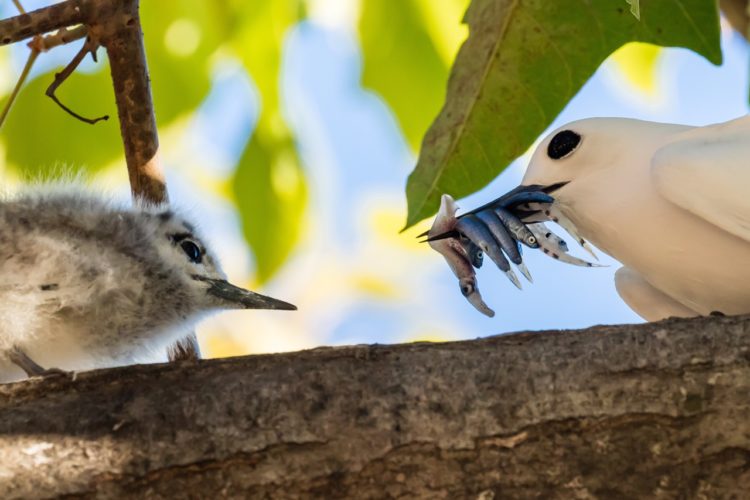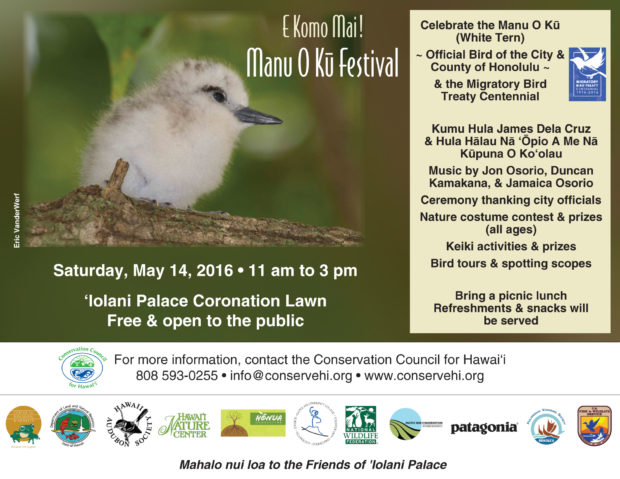We have much more to do and your continued support is needed now more than ever.
Manu O Kū: Celebrating Wildlife in Honolulu’s Urban Center

This month the National Wildlife Federation has joined with our Hawai‘i state affiliate, Conservation Council for Hawai‘i and several of our key conservation partners, to sponsor the inaugural Manu O Kū Festival in Honolulu. The festival celebrates Manu O Kū, or white tern, and the Migratory Bird Treaty Centennial. Family focused, the festival aims to create an opportunity for city dwellers to learn about and enjoy Hawaii’s wildlife right in their own backyard.
“This is an exciting event that we are thrilled to be able to bring to the public,” said Executive Director and organizer of the festival Marjorie Ziegler of the Conservation Council for Hawai‘i. “This festival gives us a chance to learn more about the rich contribution of these birds to the story of Hawai‘i.”
Only on O‘ahu
Manu O Kū is one of the few remaining native birds to live and thrive in the city of Honolulu, and can be frequently seen by people going about their daily lives. Though common in the northwestern Hawaiian Islands and across the Pacific, within the main Hawaiian Islands, they are found only on O‘ahu. With the exception of a few individuals and dedicated community members familiar with the bird, most of Honolulu’s residents remain unaware that these birds nest in the heart of the city as well as in their parks and backyards.

Manu O Kū have long been culturally important birds that are still used today in traditional Hawaiian navigation. For Hawaiian navigators, the Manu O Kū is an indicator of nearby land when out at sea. When nesting, Manu O Kū return to land daily to feed their young. When not nesting, they may travel for weeks over thousands of miles of open ocean. Though growing in numbers, Manu O Kū still face many threats, such as nonnative predators like rats, mongooses, and feral cats, human activities such as tree trimming and urban sprawl, and storms.
In 2007, the then-mayor, Mufi Hannemann, designated the Manu O Kū as the official bird of the City and County of Honolulu. “It’s a natural fit. Manu O Kū is a creature of the sea and the land” the mayor was quoted as saying at the time. “As a threatened species, it embodies the fragile nature of Hawaii’s unique environment, and we are pledged to protect both the ‘āina (land) and Manu O Kū for future generations.”
Migratory Bird Treaty Turns 100
The Manu O Kū is also being featured as part of the U.S. Fish and Wildlife Service’s Migratory Bird Treaty Centennial being celebrated this year. The first treaty was signed between Great Britain (for Canada) and subsequent treaties followed with Japan, Russia, and Mexico. These treaties form the cornerstone of conservation efforts to conserve birds that migrate across international borders.
“This festival will be an opportunity to highlight the unique nature of this bird and to also bring attention to how everyone can support their growing numbers and conservation,” said Nanette Seto, Chief of Migratory Birds and Habitat Program with the U.S. Fish and Wildlife Service. “Centennial celebrations in Honolulu and other participating cities across the country not only recognize the accomplishments of the last 100 years of bird conservation, but challenge us to build upon those successes on into the next century.”






















